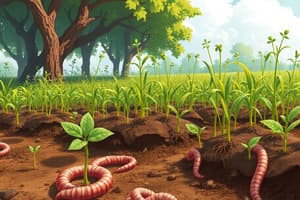Podcast
Questions and Answers
Which of the following scenarios would LEAST likely result from a significant decrease in earthworm populations within an ecosystem?
Which of the following scenarios would LEAST likely result from a significant decrease in earthworm populations within an ecosystem?
- A disruption in the food chain, impacting various animal species. (correct)
- An increase in the rate of organic matter decomposition on the soil surface.
- A decrease in the porosity and aeration of the soil structure.
- A reduction in the availability of essential nutrients for plant uptake.
Considering the interconnectedness of ecological systems, what is the MOST plausible long-term consequence of widespread earthworm extinction on agricultural practices?
Considering the interconnectedness of ecological systems, what is the MOST plausible long-term consequence of widespread earthworm extinction on agricultural practices?
- A shift towards more intensive tillage practices to artificially aerate compacted soils.
- A reduced vulnerability of crops to soil-borne diseases and pests.
- A decreased reliance on synthetic fertilizers due to enhanced natural nutrient cycling. (correct)
- An increased need for irrigation systems to counteract improved water retention in soils.
If you were examining soil samples from two different locations, one with a high earthworm population and another with a low population, which difference would you MOST likely observe?
If you were examining soil samples from two different locations, one with a high earthworm population and another with a low population, which difference would you MOST likely observe?
- The soil with a high earthworm population would have a greater proportion of coarse, sandy particles.
- The soil with a high earthworm population would demonstrate lower water infiltration rates.
- The soil with a low earthworm population would exhibit a decreased presence of worm castings.
- The soil with a low earthworm population would exhibit a higher concentration of decomposed organic material on the surface. (correct)
An ecologist is studying a forest ecosystem and notices a sharp decline in earthworm populations. Which of the following cascading effects is LEAST likely to occur as a direct result?
An ecologist is studying a forest ecosystem and notices a sharp decline in earthworm populations. Which of the following cascading effects is LEAST likely to occur as a direct result?
In an experiment simulating the absence of earthworms in a controlled environment, which of the following outcomes would MOST strongly support the hypothesis that earthworms are essential for maintaining healthy soil structure?
In an experiment simulating the absence of earthworms in a controlled environment, which of the following outcomes would MOST strongly support the hypothesis that earthworms are essential for maintaining healthy soil structure?
A farmer observes that their field consistently experiences waterlogged conditions after heavy rainfall, hindering crop growth. Considering the role of earthworms, which of the following strategies would be MOST effective in mitigating this issue?
A farmer observes that their field consistently experiences waterlogged conditions after heavy rainfall, hindering crop growth. Considering the role of earthworms, which of the following strategies would be MOST effective in mitigating this issue?
Imagine a scenario where a non-native earthworm species is introduced into a previously earthworm-free forest ecosystem. Which of the following outcomes would be the MOST likely long-term consequence?
Imagine a scenario where a non-native earthworm species is introduced into a previously earthworm-free forest ecosystem. Which of the following outcomes would be the MOST likely long-term consequence?
A research study aims to assess the impact of different agricultural practices on earthworm populations. Which of the following experimental designs would provide the MOST reliable and ecologically valid results?
A research study aims to assess the impact of different agricultural practices on earthworm populations. Which of the following experimental designs would provide the MOST reliable and ecologically valid results?
In the context of sustainable agriculture, which of the following practices would BEST promote the conservation and enhancement of earthworm populations in cultivated soils?
In the context of sustainable agriculture, which of the following practices would BEST promote the conservation and enhancement of earthworm populations in cultivated soils?
Considering the importance of earthworms in nutrient cycling, what is the MOST likely consequence of their absence on the long-term health and productivity of a natural grassland ecosystem?
Considering the importance of earthworms in nutrient cycling, what is the MOST likely consequence of their absence on the long-term health and productivity of a natural grassland ecosystem?
Flashcards
Earthworm Characteristics
Earthworm Characteristics
Worms have segmented bodies and slimy skin, with over 7,000 species living in temperate and tropical soils.
Earthworm Diet
Earthworm Diet
Earthworms eat decaying plants and roots in the soil, preventing dead plant accumulation.
Worm Castings
Worm Castings
Earthworms produce worm castings, a special type of poop that plants can absorb as nutrients.
Earthworm Tunnels
Earthworm Tunnels
Signup and view all the flashcards
Earthworms in the Food Chain
Earthworms in the Food Chain
Signup and view all the flashcards
What are worm castings?
What are worm castings?
Signup and view all the flashcards
How do earthworms improve soil?
How do earthworms improve soil?
Signup and view all the flashcards
Study Notes
No new information to add, the existing notes are identical to the new information.
Studying That Suits You
Use AI to generate personalized quizzes and flashcards to suit your learning preferences.
Description
Investigate the effects of changing earthworm populations on ecosystems. Scenarios explore ecological consequences like decreased soil fertility and altered water drainage. Understand earthworms' vital role in soil health and agriculture.





